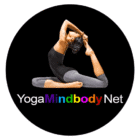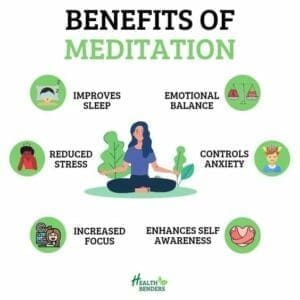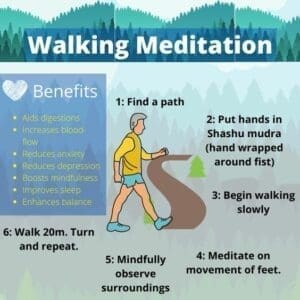Are you feeling overwhelmed by the chaos and stress of everyday life? Would you like to find a way to achieve a sense of inner peace and calm? Look no further! In our article, “Navigating The Path To Inner Peace: A Comprehensive Guide To Meditation,” we will take you on a journey to discover the transformative power of meditation. Be prepared to explore different meditation techniques, learn how to create a suitable environment, and understand the numerous benefits that meditation can bring to your life. Get ready to embark on a profound journey towards inner tranquillity and harmony.
Understanding Meditation
What is Meditation?
Meditation is a practice that has been around for centuries and is deeply rooted in various religious and spiritual traditions. At its core, meditation is a method of training the mind to focus and redirect thoughts, allowing for a deeper sense of inner peace, relaxation, and self-awareness. It involves intentionally turning your attention away from external distractions to achieve a state of mental clarity and emotional balance.
The Benefits of Meditation
The benefits of meditation are far-reaching and have been scientifically proven to have a positive impact on both physical and mental well-being. Regular meditation practice can reduce stress, anxiety, and depression, as well as improve concentration, creativity, and overall cognitive function. It has also been shown to lower blood pressure, boost the immune system, and promote better sleep. Moreover, meditation can enhance self-awareness, cultivate a sense of compassion and empathy, and foster a deeper connection with oneself and others.
Different Types of Meditation Techniques
There are numerous meditation techniques to choose from, each with its own unique focus and approach. Some of the most popular meditation techniques include mindfulness meditation, transcendental meditation, loving-kindness meditation, walking meditation, chakra meditation, and guided meditation. Exploring different techniques can help you find the one that resonates most with you and best suits your individual preferences and goals.
Preparing for Meditation
Creating a Sacred Space
Creating a sacred space for meditation can greatly enhance your practice. It provides a dedicated area that serves as a reminder to prioritize self-care and inner peace. Choose a quiet and clutter-free space in your home where you can sit comfortably without being disturbed. You can enhance the ambiance by lighting candles, burning incense, or playing soft and soothing music. Personalize your space with objects that have special meaning to you, such as crystals, inspirational quotes, or a picture of a loved one.
Choosing the Right Time
Selecting the right time to meditate is essential for establishing a consistent practice. Some people prefer to meditate early in the morning, as it allows for a peaceful start to the day and sets a positive tone. Others find that meditating in the evening helps to release the stresses of the day and promote relaxation before bedtime. Ultimately, the best time to meditate is when you can devote uninterrupted time to your practice. Experiment with different times of the day to discover what works best for you.
Ensuring Physical Comfort
Before diving into your meditation practice, it is important to ensure physical comfort. Find a posture that allows you to sit comfortably for an extended period of time. Traditionally, practitioners sit cross-legged on a meditation cushion or mat, but you can also sit on a chair or use any other supportive surface. Maintain an upright posture with a relaxed but alert stance, and avoid slouching or tensing your body. Wear loose, comfortable clothing that allows for unrestricted breathing and movement. Having a blanket or shawl nearby can be helpful for added comfort and warmth.
The Fundamentals of Meditation
Posture and Alignment
Posture plays a significant role in meditation as it supports your body and allows for optimal breathing and energy flow. Sit in a way that feels grounded and stable, with your spine straight and aligned. Imagine a string pulling you up from the top of your head, lengthening your spine and creating space between each vertebra. Rest your hands gently on your thighs or bring them together in a mudra, a symbolic hand gesture. Allow your shoulders to relax and your chest to open, creating a sense of spaciousness and ease.
Breathing Techniques
Conscious breathing is an integral part of meditation. It helps to bring focus and calmness to the mind, cantering your awareness in the present moment. Begin by observing your natural breath without trying to control it. Notice the sensation of your breath entering and leaving your body, feeling the rise and fall of your abdomen or the air flowing in and out of your nostrils. As you become more comfortable, you can explore different breathing techniques, such as deep belly breathing or alternate nostril breathing, which can further deepen your meditation practice.
Focused Attention
One of the key elements of meditation is developing focused attention. This involves directing your attention to a specific object, such as your breath, a mantra, or a visual image. Whenever your mind wanders off, gently bring it back to your chosen point of focus without judgment or frustration. The practice of focused attention helps to quiet the mental chatter and cultivate a clear and one-pointed mind. Over time, this focused attention becomes a valuable tool to bring mindfulness and presence into all areas of your life.
Mindfulness Meditation
Observing Sensations and Thoughts
Mindfulness meditation involves cultivating moment-to-moment awareness of your thoughts, sensations, and emotions without judgment or attachment. Begin by bringing your attention to your bodily sensations, noticing any areas of tension or discomfort. Then, shift your focus to your thoughts, observing them as they arise and pass without getting caught up in their content. Allow your thoughts to come and go, simply observing them from a place of non-reactivity and curiosity. Remember, the goal is not to suppress or control your thoughts, but to cultivate a sense of spacious awareness around them.
Cultivating Non-Judgmental Awareness
A core aspect of mindfulness meditation is developing a non-judgmental attitude towards your experiences. Instead of labelling thoughts or emotions as good or bad, right or wrong, simply observe them without adding any value judgments. Embrace the impermanence and fluidity of your thoughts and emotions, knowing that they are constantly changing. Cultivating non-judgmental awareness helps to cultivate a sense of compassion and acceptance towards yourself and others, fostering a greater sense of peace and harmony.
Staying Present in the Moment
Staying present in the moment is a fundamental principle of mindfulness meditation. It involves redirecting your attention back to the present whenever your mind starts to wander into past regrets or future worries. By anchoring yourself in the present moment, you cultivate a deep sense of gratitude and contentment for what is happening right here, right now. Practice bringing your awareness to your breath or the sensations in your body, and notice how being fully present can bring a sense of calm and clarity to your mind.
Transcendental Meditation
Introduction to Transcendental Meditation (TM)
Transcendental Meditation (TM) is a technique that involves the use of a mantra – a word, sound, or phrase – as a point of focus for the mind. Derived from ancient Vedic traditions, TM is simple to practice and does not require any religious beliefs or philosophy. During TM, the mantra is silently repeated in the mind, allowing the conscious mind to settle and access deeper levels of awareness. This technique is practiced for 20 minutes, twice a day, while sitting comfortably with closed eyes. TM is known for its ability to reduce stress, promote relaxation, and enhance overall well-being.
Mantras and their Significance
In Transcendental Meditation, the mantra acts as a vehicle to transcend the surface level of the mind and access deeper states of consciousness. The specific mantra used in TM is personalized and given to each individual by a trained TM teacher. These mantras are carefully selected based on factors such as age and gender and are meant to be kept private. The repetition of the mantra helps to quiet the mental chatter and allow the mind to settle into a state of inner silence and stillness.
Establishing a Routine
To fully benefit from Transcendental Meditation, it is recommended to establish a regular practice routine. Set aside specific times in your day to practice TM, ideally in the morning and evening. Find a quiet and comfortable space where you can sit uninterrupted and close your eyes. Before beginning, take a few moments to relax your body and mind. When chanting the mantra, gently and effortlessly repeat it in your mind, allowing it to resonate effortlessly. Consistency is key, so aim to practice TM every day, even if for shorter periods of time.
Loving-Kindness Meditation
Cultivating Compassion and Purity of Intention
Loving-kindness meditation, also known as metta meditation, focuses on the development of compassion, love, and kindness towards oneself and others. It involves repeating specific phrases or intentions to cultivate a warm and caring attitude. Begin by directing the phrases towards yourself, wishing for your own happiness, health, and well-being. Gradually, extend this loving-kindness to loved ones, neutral individuals, difficult people, and ultimately to all beings. Through this practice, you cultivate a deep sense of empathy, connection, and unconditional love.
Sending Love and Well-Being to Others
In loving-kindness meditation, the intention is to actively send well wishes and intentions of love and happiness to others. Visualize the person or group of people in your mind and silently recite phrases such as “May you be happy, may you be healthy, may you be safe.” Allow these phrases to resonate deeply within you, radiating love and compassion from your heart center. As you practice, notice any shifts in your own emotional state and the impact it has on your relationships with others.
Building Emotional Resilience
One of the key benefits of loving-kindness meditation is the development of emotional resilience. By practicing compassion and cultivating a loving attitude, you build a strong foundation of inner strength and resilience. This allows you to navigate challenging situations with grace and compassion, and to respond to others’ suffering with empathy and kindness. Through regular practice, you can enhance your emotional well-being, deepen your connections with others, and create a more harmonious and compassionate world.
Walking Meditation
Engaging the Body and Mind
Walking meditation is a form of meditation that combines the physical act of walking with the mindfulness of meditation. It provides an opportunity to bring your meditation practice into motion, engaging both your body and mind. Find a quiet and peaceful place to walk, preferably in nature or a quiet park. Begin walking at a slow and steady pace, paying attention to each step and the sensation of your feet touching the ground. Bring your full awareness to the movements of your legs, the rhythm of your breath, and the surroundings around you.
Focusing on Sensations and Movements
During walking meditation, focus on the sensations and movements of your body. Notice how your weight shifts from one foot to the other, the feeling of your muscles engaging and relaxing, and the gentle swaying of your arms. Be fully present with each step, feeling the contact of your foot with the earth and the subtle sensations in your feet and legs. Allow any distractions or thoughts to come and go without judgment, gently guiding your attention back to the experience of walking.
Finding Stillness in Motion
Although walking meditation involves movement, the goal is to find stillness within the motion. As you continue walking, allow yourself to experience a sense of inner calm and presence. Embrace the harmony between your body, breath, and surroundings, and notice how this integrated awareness brings a sense of tranquility and connection. With each step, you are not only moving forward physically but also deepening your connection with the present moment and cultivating a peaceful state of mind.
Chakra Meditation
Overview of the Chakra System
Chakra meditation is a practice that focuses on the seven energy centers in the body known as chakras. These chakras are believed to correspond to specific aspects of our physical, emotional, and spiritual well-being. They act as gateways for the flow of energy throughout the body, and when they are balanced and aligned, they contribute to overall health and harmony. During chakra meditation, the practitioner directs their attention to each chakra, visualizing and energizing them to restore balance and promote vitality.
Balancing and Energizing the Chakras
Chakra meditation begins by bringing awareness to each chakra and visualizing its specific color and location in the body. Starting with the root chakra located at the base of the spine, move upward, one by one, until you reach the crown chakra at the top of the head. As you focus on each chakra, imagine a vibrant and radiant ball of light, spinning and cleansing the chakra, balancing its energy. Visualize the chakra becoming clear, open, and flowing with vitality, bringing harmony and balance to your entire being.
Visualization and Mantra Techniques
In addition to visualizing each chakra, you can also incorporate mantras or affirmations to enhance your chakra meditation practice. Each chakra is associated with a specific sound or mantra that can help stimulate and activate its energy. For example, the mantra “LAM” is associated with the root chakra, while “OM” is associated with the crown chakra. As you repeat the mantra silently or out loud, allow the vibration to resonate within the corresponding chakra, further energizing and balancing its energy.
Guided Meditation
Utilizing Guided Audio or Video
Guided meditation is a wonderful tool for both beginners and experienced practitioners alike. It involves listening to a recorded audio or video that leads you through the meditation process, providing guidance and instruction along the way. Guided meditations can cover a wide range of topics, from mindfulness and relaxation to visualizations and affirmations. They are easily accessible and can be found online, in mobile apps, or through meditation teachers and centers. By following along with a guided meditation, you can deepen your practice and explore different styles and techniques.
Connecting with an Instructor or Mentor
Another way to experience guided meditation is to connect with a meditation instructor or mentor who can provide personalized guidance and support. This one-on-one interaction allows for a more tailored approach suited to your specific needs and goals. An instructor or mentor can help you navigate any challenges or questions that may arise during your meditation practice, offering encouragement and inspiration. This personal connection can deepen your understanding of meditation and provide valuable insights and techniques to enhance your practice.
Exploring Various Guided Meditation Styles
Guided meditations come in a variety of styles, each focusing on different aspects of meditation and self-discovery. Some styles may emphasize relaxation and stress reduction, while others may emphasize visualization, gratitude, or self-compassion. Explore different guided meditations to discover what resonates with you and addresses your unique needs. By trying out different styles and techniques, you can expand your meditation practice and find new ways to cultivate inner peace, self-awareness, and personal growth.
Troubleshooting Challenges
Dealing with Restlessness and Distractions
Restlessness and distractions are common challenges that arise during meditation, especially for beginners. It is important to remember that meditation is a practice, and like any skill, it requires time and patience to develop. When restlessness or distractions arise, acknowledge them without judgment or frustration, and gently guide your attention back to your chosen point of focus, whether it be your breath, a mantra, or a visualization. Be gentle and compassionate with yourself, knowing that each moment is an opportunity to learn and grow.
Falling Asleep during Meditation
Falling asleep during meditation can be a sign of physical or mental exhaustion. To avoid nodding off, make sure you are well-rested before your meditation practice. If drowsiness still persists, try meditating in a more upright position or opening your eyes slightly. You can also experiment with other techniques like walking meditation or chakra meditation to increase alertness. Lastly, consider exploring meditation earlier in the day when you are more awake and energized.
Maintaining Consistency and Discipline
Consistency and discipline are vital for establishing a regular meditation practice. It can be challenging to carve out dedicated time each day, especially with the demands of a busy life. Set realistic goals for yourself and start with shorter meditation sessions, gradually increasing the duration as you become more comfortable. Create a schedule that works for you and commit to it, treating your meditation practice as a non-negotiable appointment with yourself. Remember, even a few minutes of daily practice can have a profound impact on your well-being and overall outlook on life.
In conclusion, meditation is a powerful practice that can bring about a deep sense of inner peace, self-awareness, and well-being. By understanding different meditation techniques, preparing a sacred space, and establishing a consistent practice, you can embark on a transformative journey towards greater mindfulness and personal growth. Whether you choose to explore mindfulness meditation, transcendental meditation, loving-kindness meditation, walking meditation, chakra meditation, or guided meditation, each method offers unique benefits and the opportunity to deepen your connection with yourself and the world around you. So, take a deep breath, embrace the journey, and allow meditation to guide you on the path to inner peace.
Disclaimer
The content is purely informative and educational in nature and should not be construed as medical advice. Please use the content only in consultation with an appropriate certified medical or healthcare professional



